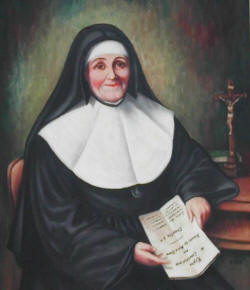More about SDC
PRAY and REFLECT
Other issues
Issue 2: Spring 2016
Download the pdf version of this issue by clicking here.
The word ‘CATECHIST’ comes from the Greek word meaning ‘to echo’. As Catechists or teachers of RE we do not proclaim our own word. We echo the message of Jesus Christ our Lord. This newsletter aims at providing parish catechists and teachers of RE in schools some support in terms of reflections, ideas, useful resources they can use and so on. Feel free to share with other colleagues and friends. There is also a pdf version which you can download by clicking on the thumbnail below.

| In this issue |
| Merciful like the Father |
| Mercy... Trust... Attraction... |
| Inspiring Teachers and Catechists - St Julie Billiart |
| Year of Mercy Resources |
| From the Writings of St George Preca |
Merciful Like the Father

The Jubilee year announced last year by Pope Francis invites us to think about the mercy of God as shown to us by Jesus his Son. It began on 8th December 2015 (feast of the Immaculate Conception) and ends on 20th November 2016 (Feast of Christ the King) As the logo caption MERCIFUL LIKE THE FATHER states, during this Jubilee year we are all invited to reflect on what we can do to show love and mercy to others in our daily life.
Mercy... Trust... Attraction...

It is not only through traditional almsgiving that mercy is shown but also by the way we live - a merciful person is someone who is welcoming, gentle and helpful. We all feel attracted to such people; they inspire trust - a quality every catechist should continually nourish. Pope Francis reminds us that ‘It is not by proselytising that the Church grows, but by attraction.’
How much are we trusted by those we teach and those who we work with in classes, groups and catechism sessions? In the words of Sherry Weddell, ‘Without some kind of bridge of trust in place, people will not move closer to God.’ This year of mercy is an opportunity to reflect about how much of a ‘bridge’ we are. How much integrity, compassion, trust and joy are we showing?

This year of Mercy is also an opportunity to stress God’s mercy in different ways we can, through our normal teaching, bible reflections, penitential services, teaching of the works of mercy, and so forth. By doing so we prepare the ‘soil’ in which the seed of mercy can grow and produce fruit. In an age when there often is distrust in the Church and religion in general, the seed that a teacher or catechist sows may be the tool through which young people are attracted to God the merciful father. It is also a seed that will grow into a tree that in time will produce more acts of mercy towards others in need.
Inspiring Teachers and Catechists - ST JULIE BILLIART

From paralysis to becoming a foundress.
Julie was born at Cuvilly, northern France. From childhood she felt the eagerness to teach. In her early teens she actually started teaching Gospel stories and catechism. Seeing her devotion, the parish priest gave her Holy Communion and Confirmation at the very young age of 9 when normal practice was that these were received at age 13. Nervously wrecked by an attempt on her father’s life, she was confined to bed with limbs paralysed. She was in her early twenties. Offering all sufferings to God, she intensified her prayer life. Her bedroom became a ‘school’ for children, especially those preparing for first Holy Communion.
Her life was dramatically changed by the upheavals of the French Revolution (1789). Priests had to hide in her house, and eventually she had to escape to Amiens. At the same time she was becoming convinced that God was inviting her to a special calling.
From her couch in the town of Amiens, Julie continued helping out in teaching. She established a close spiritual bond with a noble and virtuous lady, Countess Francoise. Together they were to fulfill her ‘dream’ of some sort of institute of religious sisters dedicated to educating poor children. This was around 1803.
In June 1804, with the intercession of the Sacred Heart of Jesus, Julie’s paralysed limbs were healed. This was another sign to persevere in her new calling, and on 15 October 1804 the first few sisters who joined her made their profession. Her spiritual director who encouraged her drew up their constitution. This was the humble beginning of the Sisters of Notre Dame. The Christian formation of girls was to be the primary aim of their institute. Recruits started coming and convents opened. Later on, around 1809 the Bishop of Amiens wanted to change their constitution to render it more traditional. Julie resisted and moved to the convent of Namur in Belgium where the Bishop accepted their original rule of life. Now her institute came to be known as the Sisters of Notre Dame of Namur. Mother Julie travelled long distances, wrote letters to form her Sisters and worked tirelessly to establish the congregation. She was greatly troubled due to the wars of Napoleon in Belgium and the safety of her sisters and convents. After the Battle of Waterloo in 1815 Mother Julie and her sisters helped to alleviate the suffering it caused, though this left its toll on her frail health and she died on 8 April 1816 at Namur. Pope Pius X beatified her on 13 May 1906. Pope Paul VI declared her a saint in 1969. Her feast day is on 8 April.
Year of Mercy Resources
Look to him and be Radiant blog
Full of resources and links you could use for class, youth groups and many more. Go to
www.looktohimandberadiant.blogspot.co.uk
Year of Mercy PowerPoint
PowerPoint presentation about the Year of Mercy and the Parables of Mercy. Download from:
SDC Resources | Presentations
From the Writings of St George Preca

Do not expect mercy if you do not show mercy. Many people are only merciful to those whom they like. They are not merciful to everybody because, blinded by their self-centredness and worldly intentions, they fail to see God’s image in every person.
Download the pdf version of this issue by clicking here.

Follow us on